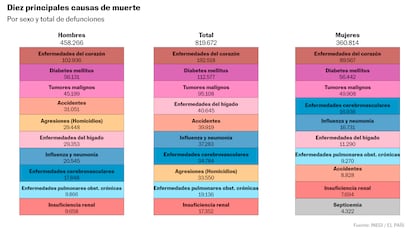During the toughest months of the pandemic, cancer patients avoided going to hospital unless it was necessary. An infection could mean death, as the treatments have greatly weakened their immune system. The rest of the population chose not to go to medical centers unless they had a serious illness, and visits not considered urgent were postponed until normality returned. Doctors agree that the effects of Covid-19 have not been sufficiently studied.
This is the first year that mortality has increased since the pandemic. In 2024, 820,000 deaths were recorded (a rate of 630 deaths per 100,000 inhabitants), 20,000 more than the previous year. Among the 10 most common causes of death in the country, malignant tumors and deaths from influenza and pneumonia are those that have seen the greatest increases.

In the case of malignant tumors, there are no epidemiological studies on the impact of the pandemic on cancer diagnosis. The oncologist and academic of the Faculty of Medicine of the UNAM, Iris Gallardo, underlines that it is not known how many patients have delayed the diagnosis or how many have detected it too late for fear of turning to medical centers. For reference, the European Cancer Organization estimated that on that continent nearly one million cases went undiagnosed due to the pandemic. In Mexico, cancer is the leading natural cause of death among children and adolescents, as well as the third in the total population, making it a public health problem, Gallardo points out.

According to Inegi data, digestive organ tumors represent 33.4% of total deaths. For men the most common cases are those that attack the prostate, while for women it is breast cancer. Gallardo says it is necessary to change the focus on groups, take into account the shortcomings and needs that low-income sectors have to broaden the focus. Forecasts for cancer deaths for 2025 estimate a decline of between 2% and 3%. However, the data for 2024 is increasing.
Most cancer deaths occur among people over the age of 65. Carlos Serrano, a general practitioner trained in oncology medicine, points out that deaths are also linked to the age of patients and the comorbidities they live with, which increases the chances of suffering from this disease. As of 2024, more than 95,000 people have died from cancer in the country.
Mauricio Rodríguez Álvarez, spokesperson for the UNAM’s epidemiological risk program, emphasizes that the comorbidity of post-Covid lung disease, which becomes chronic, affects people who contract diseases such as influenza or pneumonia. The weakness of their respiratory system can lead to death, even if there are no studies that delve into the issue, so it is launched as a hypothesis from an academic and scientific point of view. Rodríguez points out that both influenza and pneumonia have vaccines aimed at the most vulnerable populations, such as children and the elderly, so they may be preventable.

Both heart disease and diabetes mellitus occupy the top places among the causes of death in the country. The National Institute of Public Health states that obesity, overweight and hypertension are risk factors that increase the likelihood of developing both diseases. They highlight the lack of routine checks to identify the onset of diseases. As of 2023, 43% of hypertension patients in the National Health and Nutrition Survey were unaware of their disease. During 2024, more than 192,500 people died from heart disease and more than 112,500 from diabetes mellitus.
Murders continue to increase
Deaths that did not involve health problems, such as homicides, suicides and accidents, amounted to 85,282 cases. Of these, four in 10 were reported as homicides, despite government claims of a steady decline in homicides nationwide. 87% of the victims were men. Guanajuato, the state of Mexico and Baja California have recorded the majority of these deaths. Nine out of ten Guanajuato residents felt they were unsafe in their community that year.




